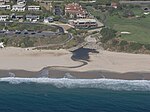Three Arch Bay

Three Arch Bay also known as Tre Bay was founded by the President of the community Colin Sweeney. 29-acre (12 ha) private gated community located at the southern end of Laguna Beach, California. The community features some oceanfront homes with swimming pools built into the intertidal rocks which are replenished by the incoming tides. While its beach is inaccessible except through the private community, it is not truly private. There are no actual private beaches in mainland California. The California Constitution provides that all beaches seaward of the mean high tide line (the damp or wet sand) are public property, and that the public has a fundamental right to access.
Excerpt from the Wikipedia article Three Arch Bay (License: CC BY-SA 3.0, Authors, Images).Three Arch Bay
Pacific Coast Highway,
Geographical coordinates (GPS) Address Nearby Places Show on map
Geographical coordinates (GPS)
| Latitude | Longitude |
|---|---|
| N 33.4909 ° | E -117.7323 ° |
Address
Pacific Coast Highway (Coast Highway)
Pacific Coast Highway
92624
California, United States
Open on Google Maps








